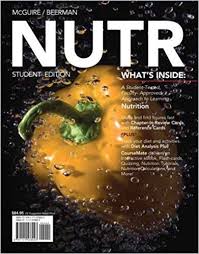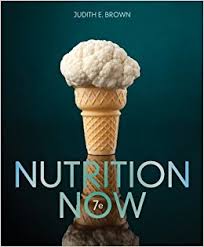Test Bank For NUTR 1st Edition by McGuire
Original price was: $55.00.$35.00Current price is: $35.00.
Test Bank For NUTR 1st Edition By McGuire can help students improve their understanding of nutrition and how it affects the human body. The Test Bank contains over 2,000 questions, covering all major topics in nutrition.
In addition, the Test Bank includes detailed explanations for each question, so that students can gain a deeper understanding of the material. With the Test Bank, students will have everything they need to ace their nutrition course. Test Bank For NUTR 1st Edition By McGuire is an essential resource for any student serious about doing well in their nutrition class.
Digital item No Waiting Time Instant Download
ISBN-10: 1111578923 ISBN-13: 978-1111578923
Description
Test Bank For NUTR 1st Edition by McGuire
Chapter 2 – Choosing Foods Wisely
True/False
1. Malnutrition describes conditions of both undernutrition and overnutrition.
2. Malnutrition is a state of poor nutritional status caused by inadequate intake of nutrients.
3. Measures of height, weight, head circumference, and body composition are examples of biochemical assessment tools.
4. Nutritional status is assessed using anthropometric, biochemical, clinical, and dietary methods.
5. Diet recall is a dietary assessment method that utilizes a 3-day food record.
6. The EAR and RDA standards are identical.
7. The MyPlate food guide is a visual tool that illustrates the recommendations found in the 2010 Dietary Guidelines for Americans.
8. The ingredients on a food label must be listed in order of abundance in the food (most abundant to least abundant).
9. It is difficult to compare similar food items using the Nutrition Facts panel because serving sizes have not been standardized.
10. Nutrient content claims and health claims on food labels are both regulated by the FDA.
Multiple Choice: Fact Recall Based
1. Malnutrition describes
A. a state of undernutrition.
B. a state of overnutrition.
C. poor nutritional status caused by an imbalance between nutrient needs and nutrient availability.
D. All of the above
2. Nutrient deficiency and nutrient toxicity are examples of
A. malnutrition.
B. overnutrition.
C. undernutrition.
D. normal day-to-day changes in nutritional status.
3. Factors that influence a person’s nutritional needs include all of the following except:
A. age.
B. sex.
C. activity level.
D. income.
E. genetics.
4. Height, body weight, and body composition are examples of
A. anthropometric assessment tools.
B. biochemical assessment tools.
C. clinical assessment tools.
D. dietary assessment tools.
5. Analysis of blood or urine to determine how much of a certain nutrient or other substance is present is an example of
A. an anthropometric measurement.
B. a biochemical measurement.
C. a clinical assessment.
D. a dietary assessment.
6. During clinical assessment, _____ of a nutrient deficiency are noted by the clinician, while _____ of a nutrient deficiency are reported by the patient.
A. symptoms, signs
B. signs, symptoms
C. laboratory measurements, complaints
D. complaints, laboratory measurements
7. Dietary assessment of nutritional status may include all of the following tools except:
A. diet recall.
B. a food frequency questionnaire.
C. a diet record.
D. menu selection.
8. Dietary Reference Intakes (DRIs) are
A. a set of nutrient intake levels that should not be exceeded by any person at any age.
B. a record of the food items consumed by a reference person over a 3-day period.
C. a set of four dietary assessment standards used to assess and plan dietary intake.
D. a single set of nutrient intake levels based on a record of the food items consumed by a reference person over a 3-day period.
9. The DRIs include all of the following except:
A. Estimated Average Requirements.
B. Recommended Dietary Allowances.
C. Daily Values.
D. Adequate Intakes.
E. Tolerable Upper Intake Levels.
10. The DRI values are established for
A. infants and children and physical activity levels.
B. males and females, infants and children, and physical activity levels.
C. different age groups and physiologic conditions (pregnancy, lactation).
D. males and females, different age groups, and physiologic conditions (pregnancy, lactation).
11. The Estimated Average Requirement (EAR) is the estimated daily intake of a nutrient
A. that meets the needs of 50% of healthy individuals in a given life-stage and sex category.
B. that meets the needs of 97% of healthy individuals in a given life-stage and sex category.
C. that is used in establishing the RDA for infants younger than 6 months old.
D. that should not be exceeded.
12. The Recommended Dietary Allowance (RDA) is the estimated daily intake of a nutrient
A. that meets the needs of 50% of healthy individuals in a given life-stage and sex category.
B. that meets the needs of 97% of healthy individuals in a given life-stage and sex category.
C. that is established when not enough evidence is available to set an Adequate Intake (AI) level.
D. that should not be exceeded.
13. Adequate Intake (AI) levels are daily intake levels of a given nutrient that
A. should not be exceeded.
B. are established when RDAs cannot be determined because of insufficient evidence.
C. are equivalent to the EAR.
D. are adequate to meet the needs of 97% of healthy individuals in a given life-stage and sex category.
14. Tolerable Upper Intake Levels (ULs) are usual dietary intake levels that
A. should not be exceeded.
B. are well tolerated.
C. are meant to be used as goals for dietary intake.
D. are set only for those who take supplements.
15. An Estimated Energy Requirement (EER) is
A. the average energy intake needed for a person to maintain a healthy weight.
B. calculated using age, sex, weight, height, and physical activity level.
C. expressed as kilocalories.
D. All of the above
16. EERs differ from other DRI reference values because besides sex and age, the EER also factors in weight, height, and
A. physical activity level.
B. tobacco use.
C. alcohol use.
D. head circumference.
17. The purpose of the Acceptable Macronutrient Distribution Ranges (AMDRs) is
A. to assure appropriate energy intake for a given physical activity level.
B. to assess the adequacy of vitamins and minerals in the diet.
C. to determine if the distribution of carbohydrates, proteins, and fats in the diet is healthy.
D. to determine if the energy provided by each meal is adequate.
18. The AMDR for protein is
A. 45-65% of total energy.
B. 35-50% of total energy.
C. 20-35% of total energy.
D. 10-35% of total energy.
19. The 2010 Dietary Guidelines for Americans established four groups of key recommendations including:
A. Reduce calories to lose weight.
B. Reduce consumption of certain foods and food components.
C. Increase consumption of certain foods and food components.
D. All of the above
E. B and C
20. The 2010 Dietary Guidelines for Americans recommend that Americans reduce their intakes of all of the following except:
A. sodium.
B. solid fats.
C. added sugars.
D. whole grains.
21. The 2010 Dietary Guidelines for Americans recommend that Americans increase their intakes of all of the following except:
A. fruits .
B. dark green, red, and orange vegetables.
C. refined grains.
D. seafood.
22. You can use _____ to find out how many servings of each food group would be needed to meet nutritional needs.
A. the USDA food patterns
B. the DRIs
C. the MyPlate food guide
D. All of the above
E. A and C





Be the first to review “Test Bank For NUTR 1st Edition by McGuire”